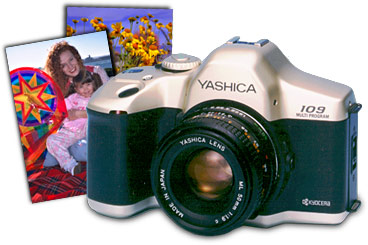Brace Yourself (and Your Camera):
Steadying You and Your Gear for Sharper Photos
Most of today's cameras and films produce superbly sharp photographs. If photographs
are fuzzy, that problem is usually due to operator error. Fuzzy photos happen because of
incorrect focusing and camera shake. You can generally take a handheld photo that's sharp
if you use a shutter speed that's faster than the focal length of the lens. For example,
if you are using a 50mm lens you can select a shutter speed of 1/60th of a second (which
on most cameras is closest to the number 50), or 1/125th, 1/250th, etc., and generally get
a crisp, sharp image. If you use a shutter speed of 1/30 or longer, you may get some
blurry photos unless you use some of the techniques listed here for bracing a camera. With
a 500mm telephoto lens, you must use a shutter speed of 1/500 of a second or faster.
If you're traveling by boat, airplane or automobile, you'll need to use high shutter
speeds such as 1/250 or faster because of movement/vibration of your means of conveyance.
Tripods are useless in such situations, because of the shake of the vehicle. (Recently
some camera manufacturers have begun manufacturing telephoto lenses with built-in
gyro-stabilizers for extra stability in these situations.)
Here are some techniques for reducing camera shake, from minimum to maximum
"hassle."
Handholding a Camera
- Be conscious of your breathing. Rather than holding your breath, which creates tension
and hence body shake, take an easy, relaxed breath, and let it out slowly. At the end of
the breath, snap your photograph.
- Keep your body loose, with knees slightly flexed and feet spread slightly apart.
- Elbows should be in. When taking a vertical (up and down) photo, this is especially
important.
- You can use your body as a camera brace. Try kneeling on your right knee, and use your
left knee as a brace for your left elbow of your arm that's holding the camera. Also, you
can sit, with both knees up, using your knees as a brace. Or, for maximum stability, try
getting in a prone position, with your body flat and both elbows on the ground.
- If you have a camera with a motor drive and don't mind "burning up" film, you
can click off a quick series of photos. Your first several frames will be throwaways, but
you may get a sharper photo by the fourth or fifth frame because of your breathing/body
position. This is an expensive and marginal technique, but sometimes works when you have
no other options.
- External Supports
- Brace a lens using existing supports. Lean against a wall or tree. Rest your camera on a
log, rock or railing (use a jacket or camera bag to protect your camera from the abrasive
effects of rocks). When you're using a "spongey" support such as a jacket or
camera bag, push the camera down onto the support.
- Professional sports photographers sometimes use a "monopod," which is like a
tripod, but with one leg. This system combines some stability with ability to move your
camera.
- A small "tabletop" tripod is inexpensive, portable and great for small lenses
and macro photography. Such tripods won't work with big telephoto lenses.
- Use a cable release when making long exposures with a tripod. This is a cord or wire
that attaches to your camera, enabling you to trip the shutter without touching the
camera.
- The larger and heavier your tripod, the more stability you have. Of course, If your
tripod is too large, you won't have it with you in situations such as backpacking. So
evaluate your needs and buy a tripod accordingly. You may want to get several tripods.
- In extremely challenging situations, such as using a tripod in windy conditions with a
long telephoto lens, you may want to weight the tripod down with your camera bag, a bag of
sand, rocks or snow. Also, with long telephoto lenses, use the tripod mount on the lens
(if available) rather than the one on the camera.
- Getting sharp images when using shutter speeds of 1/8 to1/30 of a second can be
especially challenging. Why? Even with a tripod and cable release, there's enough motion
from the cable release/shutter action/mirror motion to cause a tiny bit of camera shake.
There are several solutions to this: Use a faster shutter speed if you have enough light.
Or you can use a longer shutter speed, such as 1/2 or 1 second-or even longer, so that the
release of the camera shutter and mirro has less over-all effect. During long time
exposures such as 30-second or one-minute exposures, you can quickly place a dark card,
wallet or other object in front of the lens at the moment you trip the shutter, and again
at the end ofthe exposure, thus negating the effects of shake from the camera
shutter/mirror. Finally, some high-end cameras feature mirror lock-up, so that before you
make your exposure, you lock the mirror.
|

